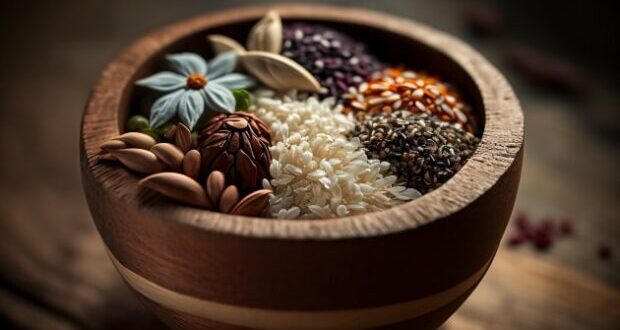Five Must Have Superfood Grains To Include In Your Diet
Do you want to ensure you eat the healthiest and most nutritious grain options? Do you want to know the top five “superfood” grains and how to include them in your diet? Then you’ve come to the right place!
This article will provide an overview of the top 5 superfood grains, their health benefits, and nutritional values. We will cover amaranth, chia, quinoa, brown rice, and pearl couscous and explain why these grains are so beneficial and how you can incorporate them into your meals.
We all know how important it is to eat a balanced and healthy diet, and this article will help you to do that. Read on to learn more about these superfood grains and why you should add them to your diet soon!
The Healthiest Grains
Superfood grains are ancient grains with nutritional properties that benefit our health. They are high in essential vitamins and minerals and packed with protein and fiber.
Some of the most popular superfood grains include amaranth, chia, quinoa, brown rice, and pearl couscous. Each of these grains means a lot of benefits for the human body. Let’s get into further details.
Amaranth: Gluten-free Fiber
Amaranth is a pseudo-cereal grain used for centuries for its nutritional value and health benefits. It is a high-protein grain, containing more protein than other grains, including wheat, corn, and rice. It also provides dietary fiber, which helps to promote regularity and improve digestion.
Amaranth is also a good source of essential vitamins and minerals, including magnesium, iron, and B vitamins.
Since it is rich in antioxidants, including amaranth seeds in a regular diet can help to protect cells from damage and reduce the risk of certain diseases. Additionally, amaranth contains a unique type of fiber known as lignans, which can help to reduce cholesterol levels and improve cardiovascular health.
Finally, amaranth is gluten-free, so it’s a good option for people with gluten sensitivities or allergies.
Chia: Carbohydrates and Minerals
This is the seed of a plant known as Salvia hispanica, related to the mint (Mentha) family. Its main characteristics are:
- The main components in chia seeds are proteins, carbohydrates, calcium, omega-3 fatty acids, dietary fiber, and antioxidant compounds.
- They provide high protein, with 17 grams per 100 grams of chia seeds.
- Chia is an excellent source of dietary fiber. It has 37 grams per 100 grams of chia.
- It is a source of healthy fats, it contains 9 grams of omega-3 fatty acids per 100 grams of chia.
- It is also a good source of minerals, such as calcium, phosphorus, and magnesium. It contains 600 milligrams of calcium, 300 milligrams of phosphorus, and 180 milligrams of magnesium per 100 grams of chia.
- Chia has high levels of antioxidants, which help protect the body from free radical damage.
Quinoa: Packed with Protein and Fiber
The quinoa plant is from the same family as Amaranth. Its seeds are considered superfood grains with a variety of health benefits.
It is a complete protein, containing all nine essential amino acids and a good source of dietary fiber, B vitamins, and minerals such as phosphorus, magnesium, and iron. Quinoa is also naturally gluten-free, an excellent alternative to wheat-based grains.
The high protein and fiber content of quinoa can help to reduce cholesterol levels and regulate blood sugar, while its magnesium content can help to reduce the risk of heart disease and stroke. The B vitamins in quinoa can also help boost the metabolism and aid in weight loss.
Being quinoa a great source of antioxidants, nutritionists recommend it for reducing inflammation and protecting the body against free radicals. It is also low in calories, which is ideal for including in a weight-control diet.
Brown Rice: Healthy and Nutritious
It is a fiber-rich grain that contains many essential vitamins and minerals. Brown rice is an excellent source of complex carbohydrates, protein, and essential fatty acids.
The fiber content helps to promote healthy digestion and may reduce the risk of certain diseases. Brown rice is also rich in antioxidants, which can help protect against oxidative damage and inflammation. Additionally, it is a good source of magnesium, which regulates blood pressure and maintains a healthy heart.
For all those health benefits, brown rice is considered one of the top-five superfood grains.
Pearl Couscous: A Staple from the Middle East
This type of pasta was developed in Israel during the decade of the 1950s. It is made from wheat and is a nutritious source of carbohydrates, proteins, and dietary fiber.
Pearl couscous is versatile in various dishes, from salads to main courses. It is an excellent addition to any healthy diet and can help provide many essential nutrients. You may visit https://riceselect.com/product/riceselect-pearl-couscous for more information and some recipes to make with this small-shaped pasta.
Nutritional Values of Pearl Couscous
Pearl Couscous is a small, round pasta made from semolina flour, also known as Israeli couscous due to its country of origin. It is high in
Carbohydrates, protein, and fat: Pearl couscous provides 4 g of dietary fiber, 6 g of protein, and only 1 g of fat per 1/4 cup serving.
Vitamins and Minerals: This tiny pasta is a good source of essential vitamins and minerals. It provides:
- 7% of the recommended daily value of vitamin B1 (thiamin).
- 8% of vitamin B2 (riboflavin).
- 4% of vitamin B3 (niacin).
- 7% of iron.
Calories: A 1/4 cup serving of pearl couscous contains 160 calories, considered a healthier alternative to white rice.
Health Benefits
The vitamins and minerals found in couscous can help to boost energy levels and support a healthy immune system. The high fiber content of pearl couscous can help to prevent constipation and promote regularity.
It is also beneficial for blood sugar control and weight management. Here are four tips for making nutritious and satisfying meals.






